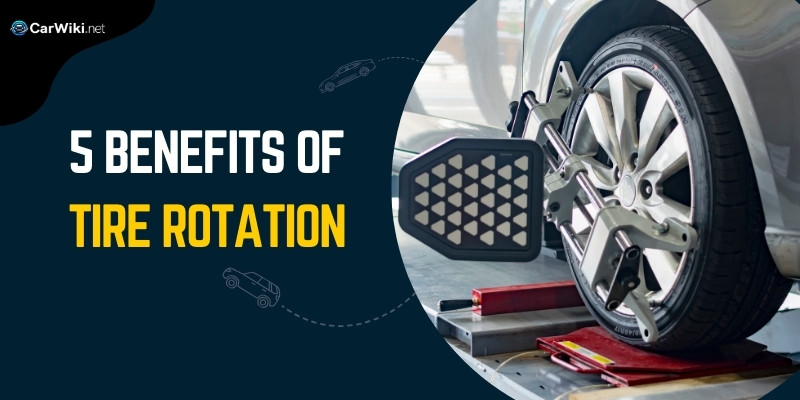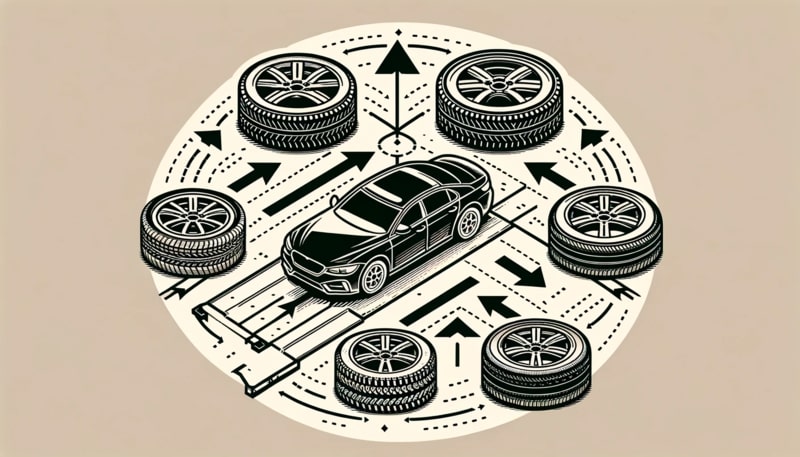5 Benefits of Tire Rotation: Enhancing Car Performance and Safety

Tire rotation, often overlooked in vehicle maintenance, is essential for tire health and efficiency. This guide highlights the various benefits of tire rotation, showcasing its significant role in enhancing vehicle performance, safety, and driving experience.
Key Takeaway: The Impact of Tire Rotation on Vehicle Efficiency
Tire rotation, essential for vehicle maintenance, plays a significant role in enhancing safety, performance, and tire longevity.
This process contributes to optimal traction and smoother rides, and can even lead to improved fuel efficiency.
Regular rotation aligns with warranty requirements and helps avoid the cost of premature tire replacements.
Quick Glance: Benefits of Tire Rotation
- Extended Tire Life: Tire rotation promotes uniform wear, thus prolonging the lifespan of your tires.
- Enhanced Safety: Balanced handling and better traction contribute to safer driving experiences.
- Improved Performance: Experience smoother rides and stable handling with regularly rotated tires.
- Cost Savings: Reducing the need for early tire replacements leads to significant cost savings.
- Warranty Compliance: Regular tire rotation is often a requirement for maintaining tire warranties.
- Better Fuel Economy: Lower rolling resistance from evenly worn tires can improve fuel efficiency.
- Uniform Wear Patterns: Regular rotation prevents issues like vibrations and one-sided wear.
What is Tire Rotation?
Tire rotation involves moving tires from one position on a vehicle to another, aiming for even tire wear.
The position of each tire on a vehicle influences how it wears; for example, front tires on a front-wheel-drive vehicle bear more weight and undergo more stress during braking and steering, wearing out faster.
Rotating these tires lets them function in all positions, leading to uniform wear.
The Benefits of Regular Tire Rotation

1. Extending Tire Life
Regular tire rotation is key to extending the life of tires. It ensures even distribution of wear across all tires, preventing any single tire from wearing out prematurely.
This helps avoid the need for costly early tire replacements and maximizes the return on your tire investment.
2. Enhancing Vehicle Safety
The condition of your tires is a critical aspect of vehicle safety. Tires that wear unevenly can compromise traction, braking efficiency, and handling, particularly in challenging weather conditions.
Rotating tires regularly maintains even tread depth, crucial for reliable road grip.
This practice enhances the vehicle’s responsiveness and reduces the risk of tire-related accidents.
3. Improving Vehicle Performance
A smooth, efficient driving experience is largely dependent on tire condition.
Evenly worn tires contribute to balanced handling and stability, ensuring optimal vehicle performance.
Issues like vibrations or pulling to one side, often a result of uneven tire wear, are minimized with regular tire rotation.
4. Preserving Tire Warranties
Tire manufacturers often require regular rotation as part of their warranty terms.
Adhering to these rotation schedules is vital to keeping warranties valid, while also offering protection against tire defects or premature wear.
5. Boosting Fuel Efficiency
Tires that aren’t rotated can lead to increased rolling resistance, requiring more fuel. Keeping tires rotated optimally maintains their condition, contributing to improved fuel efficiency.
When to Rotate Tires

A good practice is to rotate tires every 5,000 to 8,000 miles, but this can vary. Factors like driving habits, vehicle type, and tire specifications play a role.
Consulting the vehicle’s owner’s manual or a mechanic can provide a rotation schedule tailored to your needs.
Tire Rotation Patterns
Rotation patterns vary based on tire type (directional or non-directional) and vehicle drivetrain (front-wheel, rear-wheel, all-wheel, or four-wheel drive).
It’s important to use the correct pattern to ensure the best tire life and performance.
Common patterns include forward cross, rearward cross, and X-pattern, suitable for different setups.
Benefits of Tire Rotation: Conclusion
Making tire rotation a regular part of vehicle maintenance is a smart move, especially if you’re planning for a long road trip.
It brings numerous benefits in terms of safety, performance, and cost-effectiveness.
This practice is a key aspect of responsible vehicle ownership, contributing to a reliable and enjoyable driving experience.
Recommended article: Why is My Steering Wheel Making Noise?
Tire Rotation – FAQ
Can tire rotation improve fuel efficiency?
Yes, tire rotation can contribute to improved fuel efficiency. Evenly worn tires reduce rolling resistance, which means your vehicle doesn’t have to work as hard or use as much fuel to move.
Does tire rotation affect vehicle handling?
Absolutely. Regular tire rotation helps to maintain balanced handling and stability, leading to a smoother and more controlled driving experience.
Can I perform tire rotation myself?
If you have the necessary tools and knowledge, you can perform tire rotation yourself. However, for most people, it’s recommended to have this service performed by a professional to ensure it’s done correctly and safely.
Does tire rotation prevent flat tires?
While tire rotation doesn’t directly prevent flat tires, it does help in identifying potential issues early, such as uneven wear, which could lead to tire failure.





